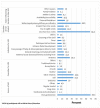Prevalence, determinants and attitude towards herbal medicine use in the first trimester of pregnancy in Cameroon: A survey in 20 hospitals
- PMID: 36962818
- PMCID: PMC10021538
- DOI: 10.1371/journal.pgph.0000726
Prevalence, determinants and attitude towards herbal medicine use in the first trimester of pregnancy in Cameroon: A survey in 20 hospitals
Abstract
To examine the prevalence, determinants and attitude towards herbal medication (HM) use in the first trimester of pregnancy in Cameroon women. Between March to August 2015, we surveyed 795 pregnant women attending 20 randomly selected urban or rural hospitals in South West Cameroon on first trimester orthodox medication (OM) and HM use. Data was obtained by interviews using structured questionnaires. First trimester HM use was reported by 293 (36∙9%) women, 76% of whom used it in combination with OM. The most frequent indication for taking HM was prevention/treatment of anaemia (26∙3%). The HM were usually self-prescribed (33∙3%) or by family (56∙2%), and obtained from the woman's own garden (69∙3%). Twenty percent of women believed that HM was always safe to take in pregnancy, compared to 69.3% for OM. Intake of HM was significantly influenced by women's opinion on OM or HM safety-the odds of taking HM was 3 time higher among women who were unsure about the safety of OM (AOR: 3∙0, 95%CI = 1∙5-6∙1), while women who thought HM were never safe or who were unsure about its safety, were 91% or 84% respectively less likely to take HM compared to women who believed HM were always safe. We identified a high prevalence of HM use and concomitant use with OM, strongly influenced by women's perception of HM and OM safety. These findings indicate the need for WHO to specifically address safety in pregnancy in its policy to integrate traditional medicine use into existing healthcare systems in Africa.
Copyright: © 2022 Leke et al. This is an open access article distributed under the terms of the Creative Commons Attribution License, which permits unrestricted use, distribution, and reproduction in any medium, provided the original author and source are credited.
Conflict of interest statement
The authors have declared that no competing interests exist.
Figures
References
-
- World Health Organisation. Traditional complementary and integrative medicine. Overview. 2022. Retrieved 07/06/2022 from: https://www.who.int/health-topics/traditional-complementary-and-integrat...
-
- Busia K. Medical provision in Africa–Past and present. Phytotherapy Research: An International Journal Devoted to Pharmacological and Toxicological Evaluation of Natural Product Derivatives. 2005;19(11):919–23. - PubMed
-
- Helwig D. Traditional African medicine. Gale Encyclopedia of Alternative Medicine2005.
LinkOut - more resources
Full Text Sources



